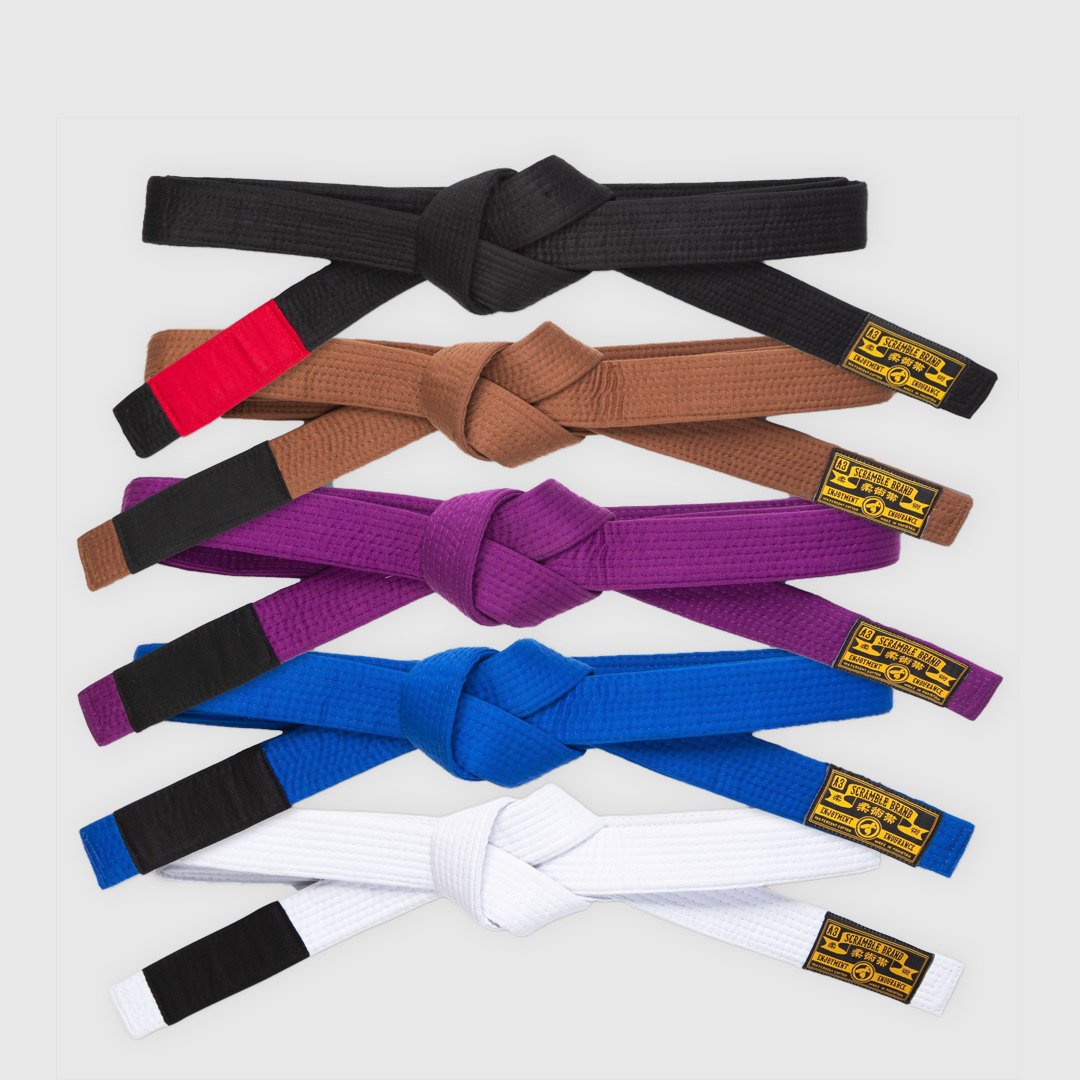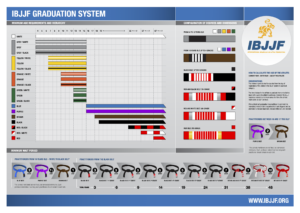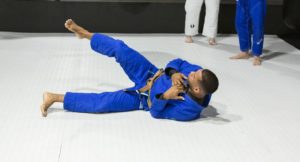Leveling up in BJJ is hard, and the BJJ belt timeline is excessively long compared to other martial arts. In fact, it takes decades before you can even get to the highest belt.
In contrast, would you believe that the youngest black belt in the world is a young girl barely out of preschool? The year 2009 saw the then five-year-old Varsha Vinod captured the attention of the world. She began training at two years old and earned her black belt after only three years. She earned her second dan black belt later at 7.5 years old.
How was she able to do that at such a young age? How much students learn and how fast they climb the ranks depends on both the students and the instructors. Most mainstream martial arts schools have grading systems that can see students earn their black belt under five years. Now, little Vinod is undeniably an exceptional case for being so young. However, it isn’t all that uncommon to see kids earn their black belts before hitting their teens.

Photo grabbed from AFMA
But that is if we’re talking about other martial arts systems. It’s a different conversation altogether when it comes to Brazilian Jiu Jitsu. BJJ is one of the few schools of martial art that has preserved the prestige of its belt ranking system.
So how does the BJJ belt system work? Before we get into that, we’ve mentioned in this article that there is no single unifying organization in BJJ. That works fantastically for diversifying grappling styles and strategies. However, the downside is that there’s no universal competition ruleset. Similarly, there is no unified belt system that applies across all BJJ schools and organizations.
In this article, we’ll go over the graduation system recommended by the largest Jiu Jitsu organization in the world: the IBJJF.
-
International Brazilian Jiu Jitsu Federation
This is the most prominent BJJ belt ranking system.
There are two categories of BJJ: Gi and No Gi. IBJJF is practically synonymous with anything to do with Gi BJJ. The primary difference is that Gi BJJ makes use of the traditional Gi, while No Gi players typically wear rash guards, fight shorts, and spats. It is home to the world’s most prestigious tournaments, and it is responsible for the most widespread ruleset for Gi competitions.
Some of the events it hosts are the following:
- World Jiu Jitsu Championship (IBJJF Worlds)
- Pan-American Championship
- European Championship
- World No-Gi Brazilian Jiu Jitsu Championship (No-Gi Worlds).
The IBJJF has one graduation system for adults and three for kids, with the BJJ school at the discretion of which kids’ graduation system to use. All categories make use of belt colours and stripes to rank each practitioner. Each BJJ belt has requirements in age and tenure before qualifying for advancement to the next belt colour.
-
BJJ Belt Colors
Photo grabbed from Jits Magazine
There are 13 BJJ belt colours in the kids’ system, from white to green/black. Once they turn 16, they move on to the adult grading system. At this point, they may become white, blue, or purple belts depending on their performance as kids.
The adult BJJ belt rankings skip every colour in the kids’ division except for white. After the white belt, adults are promoted straight to blue. In IBJJF, there are only seven belt colours in the adult graduation system. The BJJ red belt comes after black and is considered the highest-ranking belt in the sport.
-
Stripe Degrees
Photo grabbed from BJJ Fanatics
Aside from the belt colour, practitioners can earn stripes as indicators of progress. The number of stripes indicates where a student is in terms of skill compared to others in the same belt level. The total number of stripes a person can earn depends on the belt colour and the graduation system in effect.
-
Kids Graduation System
The Kids Graduation System applies to any student below 16 years old. It technically only has five colours, but each colour (aside from white) has been divided into three “sub colours”. Once the student turns 16 years old, they move on to the adult grading system.
The belt they hold at the time influences the belt they will transition to but is ultimately at the instructor’s discretion. Even a green/black belt may become an adult white belt, depending on the coaches’ assessment.
Below are the belt ranks in the Kids Graduation System, their minimum age requirements, and their potential next step in the adult grading system.
- White—no minimum age, will transition to adult white
- Grey/white, grey, grey/black—no minimum age, may transition to adult white or blue
- Yellow/white, yellow, yellow/black—minimum of seven years old, may transition to adult white or blue
- Orange/white, orange, orange/black—minimum of ten years old, may transition to adult white or blue
- Green/white, green, green/black—minimum of 13 years old, may transition to adult white, blue, or purple
The IBJJF graduation standards depend on the frequency of promotion followed by a school. There are three recommendations: monthly, quarterly, and triannual. These recommendations infer that any student who receives a stripe every promotion should rank up to the next belt after a year.
- Monthly System—Eleven stripe degrees, with the 12th degree graduating the student to the next belt. Since the belt can only accommodate four stripes, the monthly system makes use of three stripe colors to indicate degree. First to 4th degrees are white, 5th to 8th are red, and 9th to 11th are yellow.
- Quarterly System—Three stripe degrees, with the 4th degree graduating the student to the next belt.
- Triannual System—Two stripe degrees, with the 3rd degree graduating the student to the next belt.
-
The IBJJF Graduation System
The prestige of the BJJ belt system lies mainly in the fact that there is a standardized set of recommendations that prevent unfair or premature promotions. Unlike other martial arts that follow the belt ranking system, the black belt isn’t the highest colour to aim for. There are three other belts beyond black: two corals and a red.
A dedicated practitioner can earn a BJJ black belt in a matter of years. However, it will take decades before anyone can even qualify for any belt beyond black.
An important thing to note is that the periods mentioned in the IBJJF Graduation System are not absolute numbers. You don’t get promoted just because you completed the tenure requirement. It’s also about the skills you acquire as well as your dedication to your practice.
The standard IBJJF Graduation System applies to anyone aged 16 or older and will apply for the rest of their BJJ career.
-
1 BJJ White Belt
Similar to the Kids Graduation System, there is no prerequisite for a BJJ white belt. It is the beginning of your journey, and it is as a white belt that you will be laying down your foundations in BJJ.
Everything you will learn as a higher-level practitioner will depend on the sturdiness of your foundation. As a white belt, you should focus on understanding the basic techniques of each of the major ground positions. You should be able to apply these techniques in the dynamic setting as you do drills with a partner. More importantly, you must ingrain the essential technical nuances of different positions and basic techniques into your muscle memory through endless repetitions.
-
2 BJJ Blue Belt
There’s no other martial art where a single step up from white warrants an incredible amount of respect. Despite blue being the second colour in the hierarchy, many consider it to be a big achievement.
Blue belt is all about building upon the foundations you have established as a white belt with practical application. You’ll become well-familiarized with basic positioning and techniques. You’ll also polish your critical mind to be fluid in your response to your opponent’s advances. As a BJJ blue belt, you will learn to roll and submit your opponents through technical knowledge rather than pure strength.
At this level, you will open up your study and experiment with more advanced positions, guards, and passing styles. Blue belt is often the rank where a student significantly expands their technical vocabulary. It will take hundreds of hours of mat time to master new techniques and strategies.
Students must complete a tenure of two years at blue before they are eligible for promotion to purple.
-
3 BJJ Purple Belt
Receiving a BJJ purple belt denotes that you have acquired significant technical knowledge. By achieving this belt, you become qualified to help teach lower-ranked students. At this point, there aren’t any new techniques you can add to your repertoire. Rather, the purple belt is the period for polishing your A game.
Progress isn’t about acquiring new skills at this stage since you’ve already done most of that at the blue belt. Instead, it’s about patching up weaknesses and gaps in your strategies. It’s the perfect time to try out all your techniques and find the ones that work best. Sharpen them until they become something that others would hate to be facing off against.
After 18 months in purple, the student becomes eligible for promotion to brown.
-
4 BJJ Brown Belt
The purple and brown belts practically know all the same techniques. What sets brown belts apart from purple? Aside from the obvious answer of tenure, BJJ brown belts are all about executing the right move at the exact right time: strategy and precision.
A year of tenure in brown makes the student eligible for promotion to black.
-
5 BJJ Black Belt
Finally, the black belt. The black belt denotes expertise in practical and technical skills. There are ten degrees (or dan) to the black belt, with the following colours being black’s higher degrees. The minimum tenure required for the BJJ belt ranks are as follows:
- Black belt—3 years
- 1st grade black belt—3 years
- 2nd grade black belt—3 years
- 3rd grade black belt—5 years
- 4th grade black belt—5 years
- 5th grade black belt—5 years
- 6th grade black belt—7 years
All of these combined comes to a total of 31 years of tenure as a black belt before qualifying for the coral belt.
-
6 BJJ Coral Belt
Once a practitioner becomes a 7th-grade black belt, they receive an alternating black and red belt. This belt is called the coral belt or the coral snake. There are two coral belts: the 7th grade black/red and the 8th grade red/white. After a tenure of seven tears at black/red, the practitioner gets promoted to red/white. They must teach and train at red/white for ten years before moving on to the red belt.
-
7 BJJ Red Belt
The red belt is the highest colour belt anyone can achieve in BJJ. The red belt is equal to the 9th and 10th-grade black belts. In the words of Renzo and Royler Gracie, the red belt is “for those whose influence and fame takes them to the pinnacle of the art.” It is an indication that you have practised and lived the sport for the majority of your life. If, for example, a student achieves their black belt at 18 years old, the earliest they can accomplish the red belt is at 66 years old.
Holders of the red belt are addressed as Grandmasters.
-
Who is the highest graded person in BJJ at present
The highest-graded people in history would be the Gracie brothers: Carlos, Gastão, Jorge, Hélio, and Oswaldo. They were 10th degree red belts—a rank awarded only to the pioneers of BJJ.
The highest rank of any living person in BJJ is the 9th degree red belt.
-
Join the Team
Given the excessively long progression timeline of the BJJ belt ranking system, it makes sense to keep in mind that BJJ is not about the destination. Achieving a black belt is not the end of the journey. You don’t just stop after you reach a certain point. Instead, BJJ is about enjoying the process, building skills and relationships that will improve you.
Looking to begin your BJJ journey and not sure where to start? Give us a try. The Fight Centre offers the perfect learning environment for beginner and advanced students alike. You’ll get to learn from world-class martial artists while having fun and making friends at the same time. If that idea appeals to you, sign up for a free trial class here.










